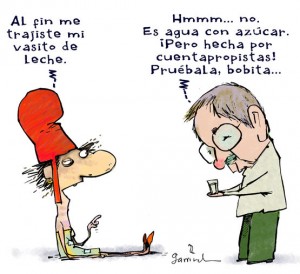
HAVANA, Cuba , October, www.cubanet.org – More than six years ago, President Raul Castro announced that he would guarantee a glass of fresh milk to the majority of children as a result of the plan to distribute this food through a group of bodegas (ration stores), experimentally. He said that as production increased, it would be extended to the whole country.
As of today, it is unknown how many bodegas and municipalities are distributing daily milk to children. Something that did not work as expected.
At the end of 2012, nationwide milk production was 516,246,500 liters. Of that amount, livestock enterprises produced 62,660,200 liters, but it is unknown what really was the destination of this production, because in none of the bodegas in the major cities in Cuba, nor in the chain stores selling in hard currency, is fresh milk or butter produced in Cuba offered.
Of the remaining 453,586,300 liters, most of it was provided by farmers who delivered 341,834,400 liters. Agricultural Production Cooperatives (CPA) and Basic Units of Cooperative Production (UBPCs) produced 111,751,900 liters.
Given their dispersal throughout the country, both private producers and cooperatives were assigned the task of ensuring that fresh milk reaches the majority of the ration stores in the municipalities that are contemplating the sale of milk.
This would be very important substitution for imports, as the price of a ton of milk powder exceeds 4,000 dollars, but it’s unknown if, in the last legislature of the National Assembly of People’s Power, the issue was analyzed by the deputies and government.
It seems that substituting for milk powder, which costs so much, for domestic production, is not among economic priorities of the current Cuban government.
With regards to milk production, the official press does not provide any information. When it does, it is very general. Evidently they are not authorized to go into detail on the matter.
Nine months into the present year we do not know how many millions of liters of milk are produced, how much has been destined for industry, what number of bodegas directly distribute it in how many municipalities, total households that receive it and what this represented in foreign exchange savings through import substitution.
The latest data available are for the period January to March, when there were 84,778,800 liters of milk. Of these, livestock enterprises reported a production of 11,297,800 liters, the remaining 73,481,700 liters were collected by cooperatives and private producers. The latter produced the most, with a delivery of 55,233,200 liters.
An example of how rapid the decline in milk production in livestock enterprises has been, we have in the province of Camagüey the largest producer of milk nationwide. In 2012, its dairies reported a production of 96,299,600 liters. Of that total, livestock enterprises only produced 43,896,600 liters. Between January and March of this year, it was reported that 14,507,500 liters were produced in Camagüey. Livestock enterprises only produced 761,800 liters.
Historically, drought served as justification to hide the poor results, but since June it has rained continuously throughout the island. Those who tore out the marabou weed, prepared the land and planted king grass so there would be no shortage of food for cows, and also provided the dairies with water and lighting for twice a day milking so that they could meet their respective production plans with no complications.
From January to August, most livestock enterprises, despite the good performance of the rain, recorded very low milk yields. Serious organizational problems, the lack of control, lack of demand, lack of foresight, have adversely affected production and brought these poor results.
By Osmar Laffita Red / ramsetgandhi@yahoo.com
From Cubanet
2 October 2013
